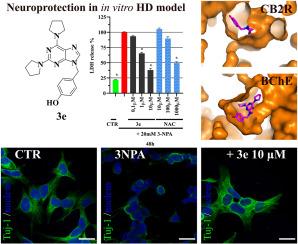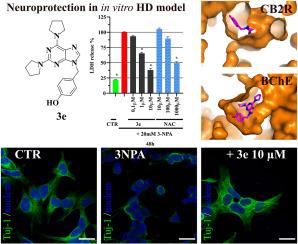Development of 2,6,9-trisubstituted purines as neuroprotective agents targeting butyrylcholinesterase and cannabinoid CB2 receptor
IF 5.9
2区 医学
Q1 CHEMISTRY, MEDICINAL
引用次数: 0
Abstract
Neurodegenerative diseases (ND) are a diverse group of disorders characterized by the progressive loss of neurons, leading to severe cognitive and physical impairments. Parkinson's, Alzheimer's, and Huntington's diseases are among the most prominent examples, with their prevalence steadily increasing due to the aging global population. In 2009, approximately 50 million people worldwide were affected by ND, and current projections suggest this number will exceed 115 million by 2050. The development of ND is complex and multifactorial, influenced by genetic predispositions, environmental factors, aging, and cellular dysfunction. A significant challenge in addressing these diseases lies in the absence of curative treatments; existing therapies are limited to symptom management and enhancing quality of life.
We report the synthesis and biological evaluation of a series of 2,6,9-trisubstituted purine derivatives, some of which exhibited strong neuroprotective effects in cellular models of mitochondrial (3-nitropropionic acid-induced) and oxidative (glutamate-induced) stress. Also, several compounds functioned as selective butyrylcholinesterase (BChE) inhibitors and three of which showed CB2 receptor agonist activity, supporting their potential as multifunctional agents for neurodegenerative disorders. In vitro assays confirmed their protective effects across multiple cellular pathways, including reduction of apoptosis, oxidative stress, and mitochondrial permeability transition. Notably, compound 3e emerged as the most effective derivative, combining strong BChE inhibition, CB2 receptor activation, and cytoprotective effects. These findings identify 2,6,9-trisubstituted purines as promising scaffolds for the development of multi-target-directed ligands in neurodegenerative disease therapy.


2,6,9-三取代嘌呤作为丁基胆碱酯酶和大麻素CB2受体神经保护剂的研究进展
神经退行性疾病(ND)是一组以神经元进行性丧失为特征的多种疾病,可导致严重的认知和身体损伤。帕金森氏症、阿尔茨海默氏症和亨廷顿氏症是最突出的例子,由于全球人口老龄化,它们的患病率稳步上升。2009年,全世界约有5000万人受到ND的影响,目前的预测表明,到2050年这一数字将超过1.15亿。ND的发展是复杂和多因素的,受遗传易感性、环境因素、衰老和细胞功能障碍的影响。应对这些疾病的一个重大挑战在于缺乏治愈性治疗;现有的治疗方法仅限于症状管理和提高生活质量。我们报道了一系列2,6,9-三取代嘌呤衍生物的合成和生物学评价,其中一些衍生物在线粒体(3-硝基丙酸诱导)和氧化(谷氨酸诱导)应激的细胞模型中表现出很强的神经保护作用。此外,几种化合物具有选择性丁酰胆碱酯酶(BChE)抑制剂的功能,其中三种化合物具有CB2受体激动剂活性,支持其作为神经退行性疾病多功能药物的潜力。体外实验证实了其在多种细胞通路上的保护作用,包括减少细胞凋亡、氧化应激和线粒体通透性转变。值得注意的是,化合物3e是最有效的衍生物,结合了强大的BChE抑制,CB2受体激活和细胞保护作用。这些发现确定2,6,9-三取代嘌呤是神经退行性疾病治疗中多靶点定向配体发展的有前途的支架。
本文章由计算机程序翻译,如有差异,请以英文原文为准。
求助全文
约1分钟内获得全文
求助全文
来源期刊
CiteScore
11.70
自引率
9.00%
发文量
863
审稿时长
29 days
期刊介绍:
The European Journal of Medicinal Chemistry is a global journal that publishes studies on all aspects of medicinal chemistry. It provides a medium for publication of original papers and also welcomes critical review papers.
A typical paper would report on the organic synthesis, characterization and pharmacological evaluation of compounds. Other topics of interest are drug design, QSAR, molecular modeling, drug-receptor interactions, molecular aspects of drug metabolism, prodrug synthesis and drug targeting. The journal expects manuscripts to present the rational for a study, provide insight into the design of compounds or understanding of mechanism, or clarify the targets.

 求助内容:
求助内容: 应助结果提醒方式:
应助结果提醒方式:


